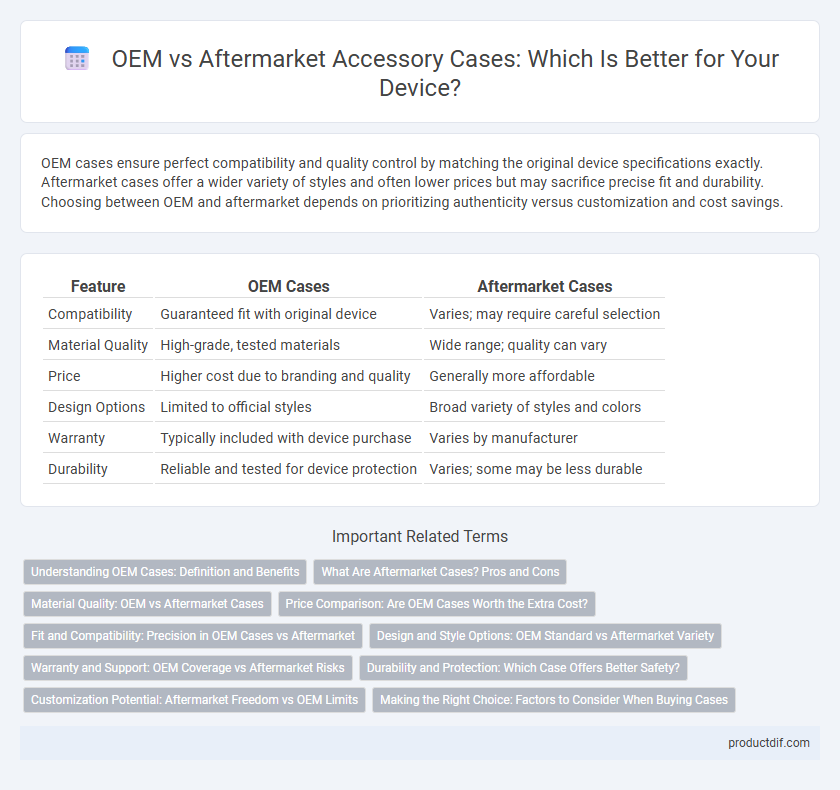OEM cases ensure perfect compatibility and quality control by matching the original device specifications exactly. Aftermarket cases offer a wider variety of styles and often lower prices but may sacrifice precise fit and durability. Choosing between OEM and aftermarket depends on prioritizing authenticity versus customization and cost savings.
Table of Comparison
| Feature | OEM Cases | Aftermarket Cases |
|---|---|---|
| Compatibility | Guaranteed fit with original device | Varies; may require careful selection |
| Material Quality | High-grade, tested materials | Wide range; quality can vary |
| Price | Higher cost due to branding and quality | Generally more affordable |
| Design Options | Limited to official styles | Broad variety of styles and colors |
| Warranty | Typically included with device purchase | Varies by manufacturer |
| Durability | Reliable and tested for device protection | Varies; some may be less durable |
Understanding OEM Cases: Definition and Benefits
OEM cases are original equipment manufacturer products designed specifically by the device maker to ensure perfect fit, compatibility, and durability. These cases undergo stringent quality control measures, offering reliable protection and warranty coverage that aftermarket cases may lack. Choosing OEM cases guarantees seamless integration with device features such as buttons and ports, enhancing user experience and longevity.
What Are Aftermarket Cases? Pros and Cons
Aftermarket cases are third-party protective covers designed for smartphones, laptops, and other devices, offering a wide range of styles and materials beyond OEM options. They often provide enhanced customization and affordability but may lack the precise fit, durability, or quality assurance found in OEM cases. Users benefit from greater variety and lower costs with aftermarket cases, though compatibility and long-term protection can sometimes be compromised.
Material Quality: OEM vs Aftermarket Cases
OEM cases typically use high-grade materials that meet manufacturer specifications, ensuring durability and precise fit for the device. Aftermarket cases often vary widely in material quality, with some using cheaper plastics or synthetic blends that may compromise protection and longevity. Consumers seeking optimal device safety and aesthetics generally prefer OEM cases for superior material integrity and consistency.
Price Comparison: Are OEM Cases Worth the Extra Cost?
OEM cases typically command higher prices due to brand assurance, precise fit, and quality materials, ensuring device protection and compatibility. Aftermarket cases, though more affordable and diverse in design, may lack the rigorous quality control and exact dimensions of OEM counterparts, potentially compromising device safety. Buyers prioritizing premium protection and guaranteed compatibility often find OEM cases worth the extra investment despite the cost difference.
Fit and Compatibility: Precision in OEM Cases vs Aftermarket
OEM cases offer precise fit and full compatibility as they are manufactured according to the original device specifications, ensuring all ports, buttons, and features align perfectly. Aftermarket cases may vary in fit quality, with some models potentially causing issues such as misaligned cutouts or hindered functionality due to less stringent manufacturing standards. Choosing OEM ensures seamless integration and reliable protection tailored specifically for the device model.
Design and Style Options: OEM Standard vs Aftermarket Variety
OEM cases offer standardized designs that ensure seamless compatibility and consistent quality aligned with the original device specifications. Aftermarket cases provide a wide variety of styles, colors, and materials, catering to personalized aesthetics and unique user preferences. The extensive aftermarket options allow for customization beyond the limited OEM standard lineup, enhancing both protection and individual expression.
Warranty and Support: OEM Coverage vs Aftermarket Risks
OEM cases typically come with manufacturer-backed warranties that guarantee product quality and provide reliable customer support, ensuring protection against defects and malfunctions. Aftermarket cases often lack comprehensive warranty coverage, increasing the risk of inadequate support and potential compatibility issues. Choosing OEM cases reduces the likelihood of voiding device warranties and ensures access to authorized repair services.
Durability and Protection: Which Case Offers Better Safety?
OEM cases are designed specifically by the original device manufacturer, ensuring precise fit and optimized materials for superior durability and protection against drops and impacts. Aftermarket cases vary widely in quality, with some offering robust materials and shock absorption, but others may compromise on fit and overall safety. For users prioritizing maximum device safety, OEM cases generally provide more reliable and tested protection, although premium aftermarket brands can offer competitive durability.
Customization Potential: Aftermarket Freedom vs OEM Limits
Aftermarket cases offer greater customization potential by allowing users to modify materials, add unique design elements, and integrate additional features not available in OEM cases. OEM cases typically follow strict manufacturer specifications, limiting personalization and accessory compatibility. This flexibility in aftermarket cases caters to consumers seeking tailored aesthetics and enhanced functionality beyond factory presets.
Making the Right Choice: Factors to Consider When Buying Cases
OEM cases ensure perfect compatibility, original material quality, and warranty protection, making them ideal for users prioritizing reliability. Aftermarket cases offer diverse designs, customizable features, and often lower prices, appealing to budget-conscious or style-focused buyers. Consider factors including fit accuracy, material durability, brand reputation, and pricing before deciding between OEM and aftermarket cases.
OEM cases vs aftermarket cases Infographic

 productdif.com
productdif.com